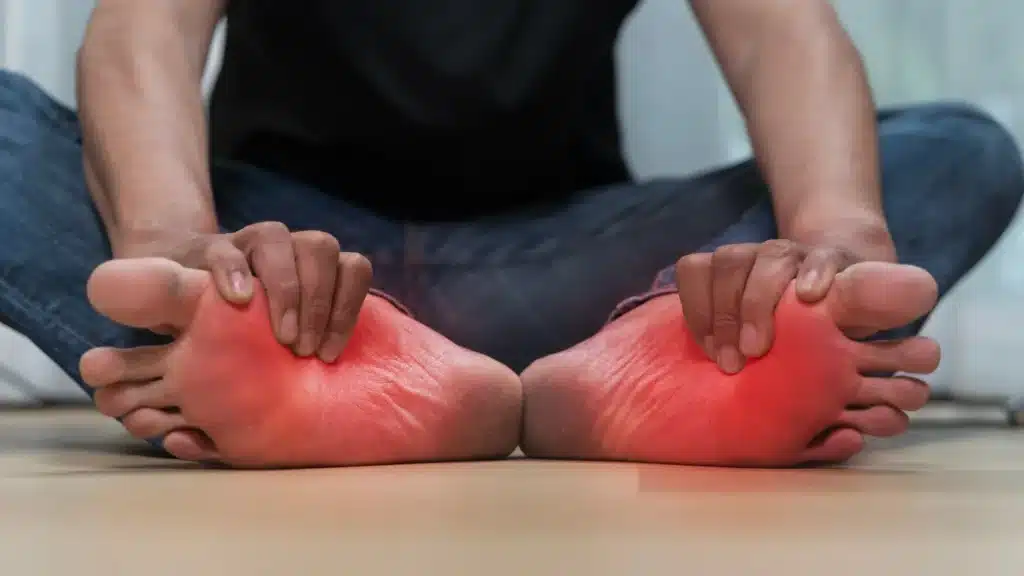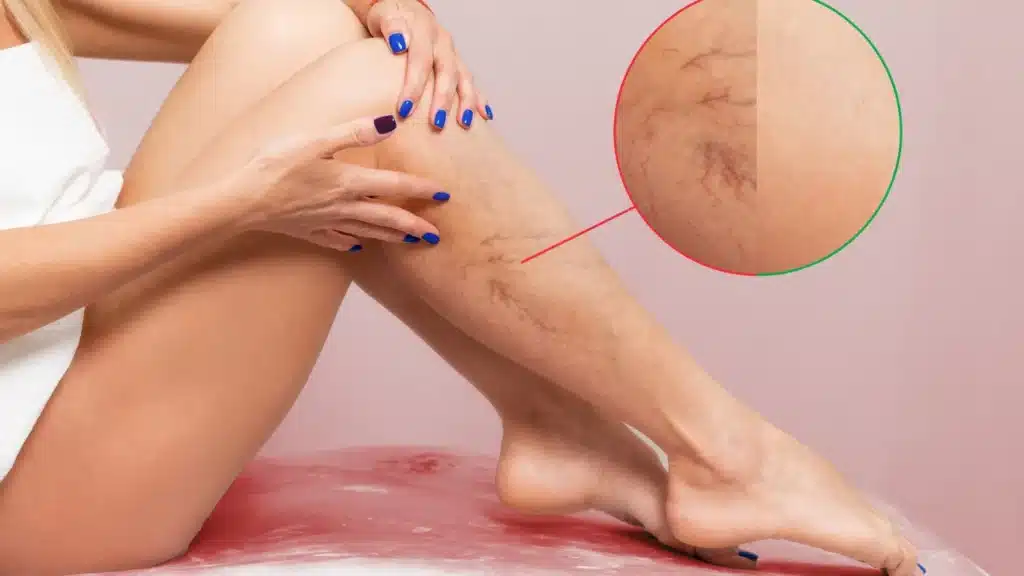Long-haul flights can be exciting, but for many passengers, they come with the risk of developing a serious health condition known as Deep Vein Thrombosis (DVT). This condition occurs when a blood clot forms in one of the deep veins of the body, often in the legs, and can have severe consequences if not addressed.
One of the most effective ways to reduce the risk of DVT while travelling is by wearing compression socks. In this blog, we’ll explore what DVT is, why it’s a concern for frequent travellers, and how wearing compression socks can help protect your health during long flights.
Key Takeaways
- DVT is a serious condition that can result from prolonged immobility during travel.
- Compression socks improve circulation, reduce swelling, and lower the risk of blood clot formation during long flights.
- Wearing compression socks from takeoff to landing can help prevent DVT and make travel more comfortable.
- In addition to wearing compression socks, staying hydrated, moving around, and doing in-seat exercises can further reduce your DVT risk.
- Pregnant women are at a higher risk of developing DVT during travel, and compression socks provide critical support to reduce that risk.
- At LMC Footcare, located in Vaughan and Bayview/Midtown Toronto, we understand the importance of preventing health complications during travel, and we offer high-quality compression socks designed to support your circulation and prevent DVT.
What is Deep Vein Thrombosis (DVT)?
Deep Vein Thrombosis (DVT) occurs when a blood clot forms in one of the deep veins of the body, typically in the legs. This condition can develop when blood flow slows down, often during prolonged periods of immobility, such as sitting on a long flight.
The blood clot can restrict blood flow, causing pain, swelling, and potential long-term health complications. The most concerning risk is that the clot may break loose and travel to the lungs, causing a pulmonary embolism, which can be life-threatening.
Why Are Long Flights a Risk Factor for DVT?
Long flights, especially those lasting more than four hours, significantly increase the risk of developing DVT for several reasons:
- Prolonged Immobility: During a flight, passengers often remain seated for long periods, which slows down the circulation in their legs. This stagnation can lead to blood pooling in the lower extremities and increase the chances of clot formation.
- Cabin Pressure: The cabin pressure in an airplane is lower than at sea level, which can affect blood flow and cause fluid retention. This, combined with limited movement, can contribute to the formation of blood clots.
- Dehydration: The dry air in the cabin can lead to dehydration, which thickens the blood and may further increase the risk of clot formation.
- Reduced Oxygen Levels: Lower oxygen levels during a flight can also affect circulation, making it harder for your body to pump blood effectively to the extremities.
What Are the Symptoms of DVT?
Not everyone with DVT experiences obvious symptoms. However, if you do experience any of the following symptoms during or after a flight, it’s important to seek medical attention:
- Pain or tenderness in the leg, especially when standing or walking
- Swelling in one or both legs, often accompanied by a feeling of heaviness or discomfort
- Red or discolored skin on the affected leg
- Warmth in the affected area
- Chest pain or difficulty breathing (This is a medical emergency and may indicate a pulmonary embolism).
If you experience any of these symptoms, contact a healthcare professional immediately.

How Compression Socks Help Prevent DVT During Long Flights
Compression socks are a simple but effective solution for reducing the risk of DVT, especially during long flights. Here’s how they work:
1. Improved Blood Circulation
Compression socks apply graduated pressure to the legs, with the most pressure around the ankle and less pressure as the sock moves up the leg. This design helps promote blood flow, encouraging blood to move upwards toward the heart rather than pooling in the lower extremities. By improving circulation, compression socks reduce the likelihood of clot formation, which can lead to DVT.
2. Reduced Swelling
Swelling is a common issue during long flights, and it can increase the risk of blood clots. Compression socks help prevent fluid buildup in the legs by gently compressing the tissues and encouraging fluid to move back into the circulatory system. This helps prevent the discomfort and swelling that often accompany long periods of sitting.
3. Lowered Risk of Clot Formation
By enhancing circulation and reducing fluid retention, compression socks decrease the risk of blood clots forming in the legs. The compression forces the veins to work more efficiently, which helps prevent the blood from stagnating and forming clots.
4. Support for the Muscles and Veins
Compression socks also provide support for the veins and muscles in the lower legs. This support helps reduce fatigue and muscle strain, which are common when sitting for extended periods. They also help with venous tone and keep veins from becoming distended, which can contribute to blood clot formation.
Compression Socks for Pregnant Women: Why They’re Essential During Travel
Pregnancy introduces several changes to the body, including an increased risk of developing Deep Vein Thrombosis (DVT). Pregnant women are more susceptible to DVT because the growing uterus puts pressure on the veins in the legs, reducing circulation. Hormonal changes also cause the blood to become thicker, which can increase the risk of clot formation.
Long flights or car trips can exacerbate these risks, especially if the pregnant woman is sitting for long periods without movement. That’s where compression socks come in; they help improve circulation and reduce swelling, two common pregnancy-related concerns.
How Compression Socks Help Pregnant Women:
- Reduced Swelling: Swelling in the legs and feet is common during pregnancy. Compression socks help reduce this swelling by promoting healthy blood flow and fluid movement.
- Prevent DVT: Pregnant women are more prone to blood clots, especially during long periods of immobility. Wearing compression socks can help lower the risk of developing DVT while travelling.
- Comfort and Support: Compression socks provide relief from tired, aching legs, a common symptom of pregnancy, especially during long trips. The added support helps improve overall comfort and prevent fatigue.
When Should You Wear Compression Socks on a Flight?
Ideally, compression socks should be worn during the entire flight, from takeoff to landing. It’s especially important to wear them for longer flights, typically over four hours, and for any flight where you are unable to move around frequently. If you’re prone to DVT or have a history of circulation problems, it’s even more important to wear compression socks regularly.
Other Tips for Reducing DVT Risk While Flying
While wearing compression socks is a key preventive measure, there are additional strategies you can use to further reduce the risk of DVT during travel:
- Move around regularly: Stand up and walk around the cabin at least once every hour to keep the blood flowing in your legs.
- Do leg exercises in your seat: Flex and extend your ankles, rotate your feet, and stretch your legs while sitting to encourage circulation.
- Stay hydrated: Drink plenty of water throughout your flight to prevent dehydration and help maintain healthy blood viscosity.
- Avoid crossing your legs: Crossing your legs can restrict blood flow, increasing the risk of clot formation.
- Wear loose-fitting clothing: Tight clothing can restrict circulation, so opt for comfortable, loose-fitting attire.
FAQs About Compression Socks and DVT Prevention
1. Can compression socks help with DVT during other forms of travel, like car or bus rides?
Yes, compression socks are beneficial during any long period of immobility, whether you’re on a flight, bus, or car ride. They help improve circulation and reduce swelling, making them useful for any extended sitting situation.
2. How tight should compression socks be?
Compression socks should fit snugly but not be uncomfortable or restrict blood flow. They are designed to apply pressure in a graduated manner, with the most pressure at the ankle and less as they move up the leg. A footcare specialist (chiropodist) at LMC Footcare can help determine the right level of compression based on your needs.
3. Are compression socks only for people with a history of DVT?
No, compression socks are beneficial for anyone who is at risk of DVT, such as frequent travellers, people with sedentary jobs, or those who have had surgery. They can be worn as a preventive measure to promote circulation and reduce the risk of clot formation.
4. Can I wear compression socks after a flight?
Yes, wearing compression socks after a flight can help reduce swelling and improve circulation as your body adjusts to being back on solid ground. They can also provide relief if you experience fatigue or discomfort after travel.
5. How do I choose the right compression socks for travel?
When selecting compression socks, consider the level of compression and the length of the sock. For travel, 20-30 mmHg compression is typically recommended. Be sure to choose socks that are comfortable for extended wear, and consider consulting with a footcare specialist (chiropodist) at LMC Footcare to find the best fit for your specific needs.
Conclusion
Travelling, especially long flights, comes with its set of challenges, but Deep Vein Thrombosis (DVT) doesn’t have to be one of them. Compression socks are a simple yet highly effective way to improve circulation, reduce swelling, and significantly lower your risk of DVT while flying. At LMC Footcare, our footcare specialists (chiropodists) can help you find the perfect pair of compression socks tailored to your needs, ensuring you travel safely and comfortably.
If you’re planning a long flight or frequent travel, visit us in Vaughan or Bayview/Midtown Toronto and ensure your legs stay healthy and pain-free during your next journey.















